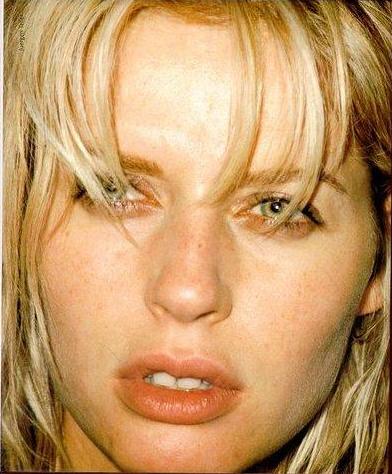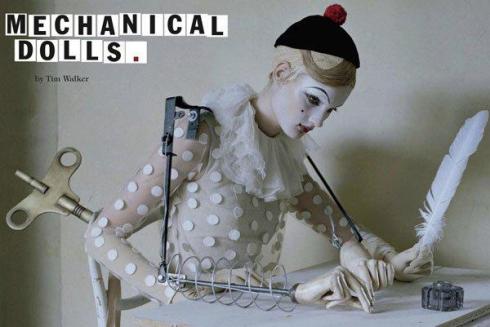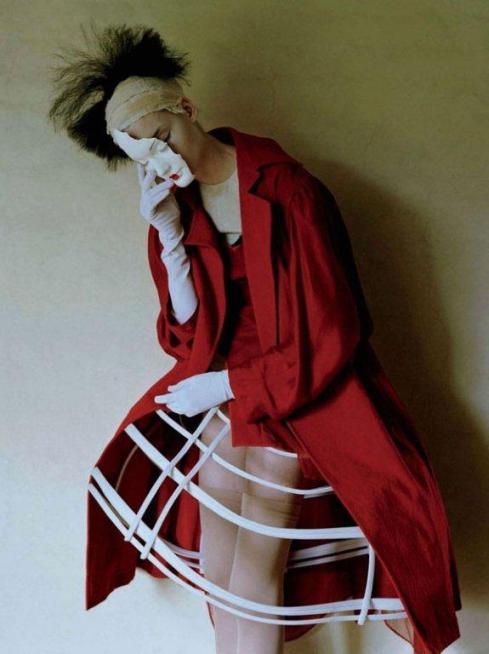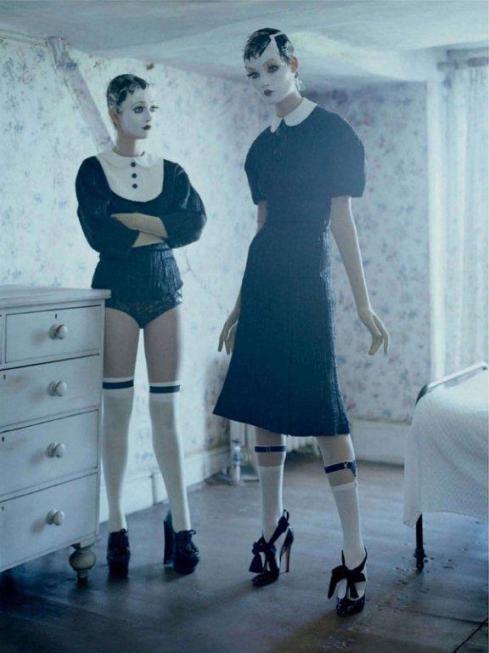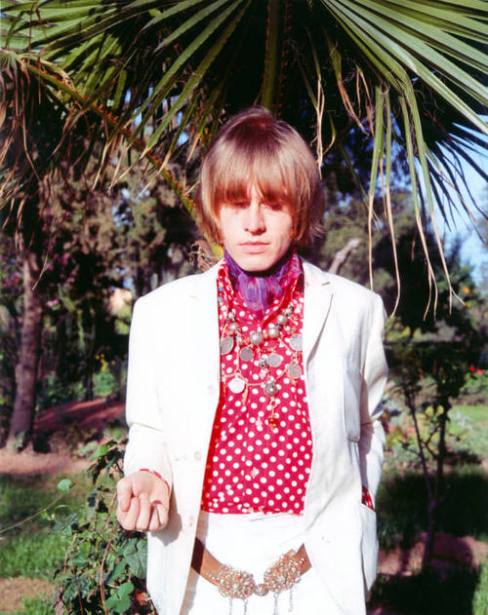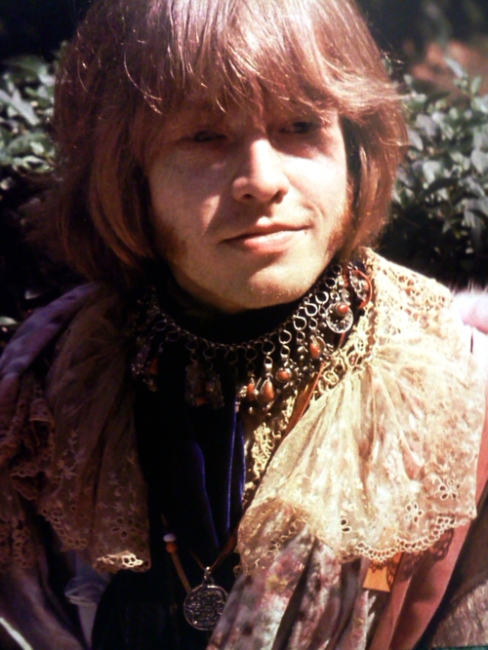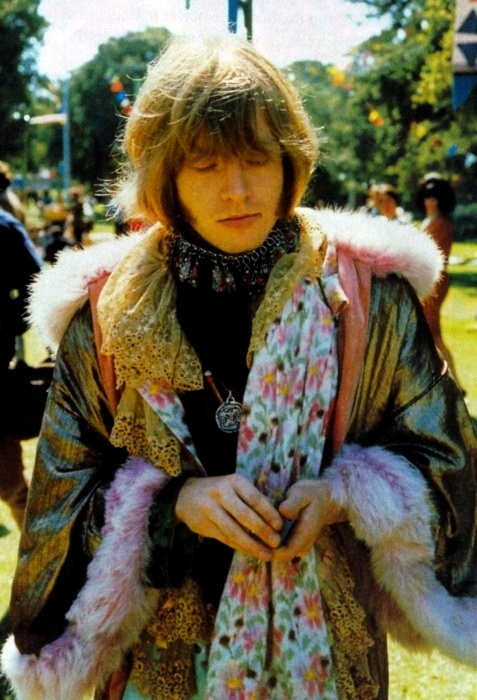Fashion photographer David Sims is born in Yorkshire, England in 1966. He leaves secondary school when he is 17 and soon starts assisting photographers Robert Erdmann and Norman Watson. At 19 he steps out on his own and gets his work published in i-D. He also starts collaborating with make-up artist Dick Page and hairstylist Guido Palau. He becomes one of the ‘new photographers’, who are partially responsible for the changes in fashion photography in the 90ties.
In 1993, David Sims is hired by Calvin Klein to shoot an ad campaign with Kate Moss and for this David Sims becomes internationally recognized. He signs a one-year exclusive contract to Harper’s Bazaar (USA).
In the post ‘fashion photography changed in the 90ties’ I showed some early pictures of David Sims, modelled by Emma Balfour and his first i-D cover of February 1996, starring Kate Moss covering one eye with her hand. Another series that stayed with me is published in Harper’s Bazaar in ’93, modelled a young Linda Evangelista.
Harper’s Bazaar US, September 1993. ‘Anatomy of a suit’
.
David Sims’s photographs appear at the Howard Greenberg Gallery in New York and in ’94 and he is named Young Fashion Photographer of the Year. But it is his ’95 campaign for the Japanese avant-garde designer Yohji Yamamoto that is the real turning point in his career.
Yohji Yamamoto campaign 1995
In ’96 David Sims is named Photographer of the year at the International Festival of Fashion Photography, beating Steven Meisel, Juergen Teller, Craig McDean, Mario Testino and David LaChapelle. He also starts working with menswear designer Raf Simons. Together they produce ‘Isolated Heroes’, a collection of portraits of Raf Simons’s unconventional models dressed in his s/s 2000 collection. This eventually develops into a book and a traveling exhibit.
Isolated Heroes
.
In 2000 Women’s Wear Daily (WWD) reports the days of alternative fashion magazines may be coming to an end, as’”phtographers once synonymous with the underground are now employed by the likes of Vogue“.
In 2002 David Sims becomes romantically involved with Luella Bartley, a fashion journalist turned designer. Soon son Kip Sims is born, two years later followed by daughter Stevie Sims and in 2007 second son Ned Sims joins the family. When he’s not travelling the world shooting for the world’s top fashion magazines, David can be found hitting the surf in Cornwall, where family lives.
.
David Sims known as a very private person and prefers to leave little trace- only the beautiful photographs he makes. his style has shifted with time, becoming more kinetic and less nitty-gritty after the turn of the millennium. David Sims still prefers to shoot against a plain backdrop, but he instructs his models to bend, jump, and otherwise push the edges of the frame. He works for Vogue not just with one main fashion editor, but with all the magazine’s stalwarts: Grace Coddington, Tonne Goodman, Camilla Nickerson, and Phyllis Posnick.
Vogue Paris 2009, Kristen McMenamy

.
Luella Bartley, an English writer and magazine editor who first became famous for her now-defunct fashion label, has admitted to being nervous about revealing new projects—say, a book cover or home-decorating scheme—to him. Why? Because he is an arbiter of extreme discernment. (“Dave has such amazing taste, so he always ends up doing the house,” she said in 2007.) The couple, both fanatic surfers, live near the waves in a seventeenth-century farmhouse in Bodmin, Cornwall. When the writer Mark Holgate visited Luella Bartley—and their children, Kip, Stevie, and Ned—for a Vogue profile in 2006, she said that she and her husband share a need to create their own atmosphere and surroundings: “We will get the most beautiful piece of furniture, something that cost a fortune,” she said, “and we have to do something to it—scratch it, slap on stickers, anything—to make it ours.”
.
David Sims & Luella Bartley are named in The Independent’s list of style influencers in 2009. When Emmanuelle Alt, editor-in-chief, spoke about her vision as the new editor in chief of French Vogue, David Sims’s name popped up. He’s been tapped by Prada and Yves Saint Laurent to do advertisements and after photographing Kate Moss with ‘faux-cropped’ short hair for the book Heads: Hair by Guido, she was inspired to cut her hair for real. All these proof positive of how the understanding and taste of this least self-promoting of fashion photographers is respected across the industry.
W magazine, February 2009 Alexandra Deshorties is ‘Aria’
.
.
Vogue Paris November 2012, ‘Le Noir Dans La Peau’
.
Alexander McQueen s/s 2012
.
.
Alexander McQueen s/s 2013
The Alexander McQueen collection s/s 2013 runs with a beekeeper inspiration … For the campaign pictures model Raquel Zimmermann has her entire hair, face and shoulders (and the statement collared-necklace she’s wearing) dripped in honey.
.


.
Visionaire issue 40/ Roses
For this issue of Visionaire, Sims reveals a personal project that he has been working on for several years. ”I think of these roses as portraits. ” Sims explains, ”I was a pupil at the school where these roses grow…when I look at these roses close up and trace their own knocks and dents, I find a greater beauty and a complexity in their imperfections. The roses represent for me a very definite point in life and a state of mind. ”
http://www.amazon.com/Visionaire-No-40-David-Sims/dp/1888645199
most information: Voguepedia
Filed under: biography, inspiration



























































